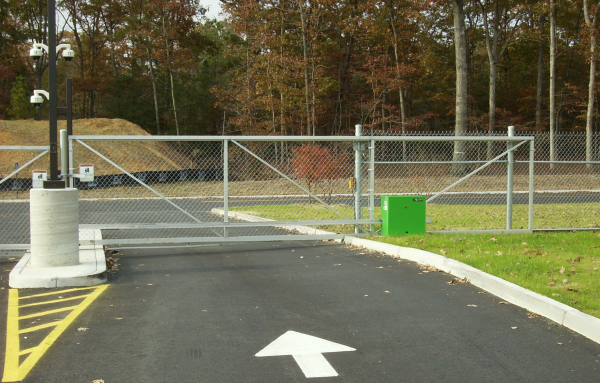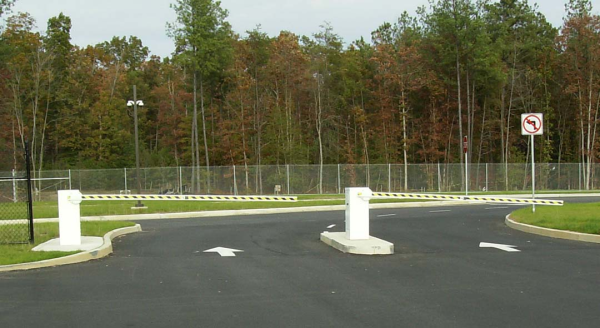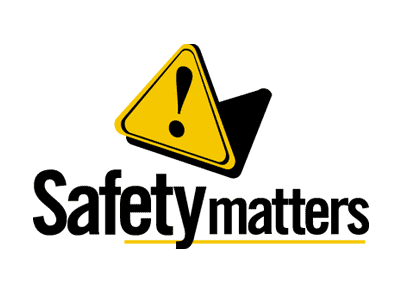
Automated
gate operators require safety devices, known as Entrapment Protection, to prevent moving gates from striking individuals or vehicles. The standard set for Automated Gate Operation is the UL325 standard as set by
The Underwriter’s Laboratory and it consists of four classes of gates. Class 1 is a gate operation that most likely to come in contact with the public such as a personal residence. Class 2 is intended for commercial locations or multi-family housing units, hotels or garages. Class 3 is intended for an industrial location, factory or an area not intended to serve the general public. Finally, Class 4 is placed in a location such as an airport, restricted areas or any area that is restricted to public access.
The lower the class of gate, such as Class 1, the more safety devices will be required. These devices can consist of vehicle detection safety loops, photo eye sensors, gates edges, adjustable clutches, continuous pressure opening or closing devices, strobe lights and audio alarms are probably the most used safety devices for gate systems. These devices are explained in more detail below. Class 1 and 2 gates will require a combination of several safety devices to meet a UL325 rating. Class 3 requires two devices and Class 4 only requires one.
Safety loops are wire sensors that are buried in the existing surface area of a gate. They are designed to sense the presence of metal (maybe a vehicle or lawn mower) and they will hold the gate open or actually reverse the gate when a metal presence is noted. Photo safety eyes project a photosensitive beam that, if broken, indicates an obstruction and reverses the gate away from that object. Gate Edges actually reverse a moving gate when pressure is applied to the edge itself. The gate edge strip is attached the leading edges of a gate and if pressure is applied to that edge an obstruction is noted and the gate will automatically reverse. Continuous pressure open or close buttons will stop a gate as soon as pressure is released from the button in use. Audible and visual alarms provide protection for those distracted by other events or who may be handicapped in some manner.
Automated gate installations are best served by a combination of photo both safety cells and safety loops. Vehicle and pedestrian safety are best addressed when this combination is used, and the UL325 standard can be maintained.
 Barrier arms
Barrier arms require the same devices as gates. The number of loops required will vary with each type of gate access control system. As a rule slide gates require two loops, barrier gates require two loops and swing gates require three. All other safety devices can be used as designed in any of these installations.
Gate automation must be a secure yet safe to operate. The previously mentioned steps should be taken to protect people and property from unintended injury or damage during the opening or closing of any automated gate. If you have a question as to what class of gate you have or what safety devices you need to reach a certain certification just ask you
operator or access control provider to help design a system to meet your desired safety requirement.

 Automated gate operators require safety devices, known as Entrapment Protection, to prevent moving gates from striking individuals or vehicles. The standard set for Automated Gate Operation is the UL325 standard as set by The Underwriter’s Laboratory and it consists of four classes of gates. Class 1 is a gate operation that most likely to come in contact with the public such as a personal residence. Class 2 is intended for commercial locations or multi-family housing units, hotels or garages. Class 3 is intended for an industrial location, factory or an area not intended to serve the general public. Finally, Class 4 is placed in a location such as an airport, restricted areas or any area that is restricted to public access.
The lower the class of gate, such as Class 1, the more safety devices will be required. These devices can consist of vehicle detection safety loops, photo eye sensors, gates edges, adjustable clutches, continuous pressure opening or closing devices, strobe lights and audio alarms are probably the most used safety devices for gate systems. These devices are explained in more detail below. Class 1 and 2 gates will require a combination of several safety devices to meet a UL325 rating. Class 3 requires two devices and Class 4 only requires one.
Safety loops are wire sensors that are buried in the existing surface area of a gate. They are designed to sense the presence of metal (maybe a vehicle or lawn mower) and they will hold the gate open or actually reverse the gate when a metal presence is noted. Photo safety eyes project a photosensitive beam that, if broken, indicates an obstruction and reverses the gate away from that object. Gate Edges actually reverse a moving gate when pressure is applied to the edge itself. The gate edge strip is attached the leading edges of a gate and if pressure is applied to that edge an obstruction is noted and the gate will automatically reverse. Continuous pressure open or close buttons will stop a gate as soon as pressure is released from the button in use. Audible and visual alarms provide protection for those distracted by other events or who may be handicapped in some manner.
Automated gate installations are best served by a combination of photo both safety cells and safety loops. Vehicle and pedestrian safety are best addressed when this combination is used, and the UL325 standard can be maintained.
Automated gate operators require safety devices, known as Entrapment Protection, to prevent moving gates from striking individuals or vehicles. The standard set for Automated Gate Operation is the UL325 standard as set by The Underwriter’s Laboratory and it consists of four classes of gates. Class 1 is a gate operation that most likely to come in contact with the public such as a personal residence. Class 2 is intended for commercial locations or multi-family housing units, hotels or garages. Class 3 is intended for an industrial location, factory or an area not intended to serve the general public. Finally, Class 4 is placed in a location such as an airport, restricted areas or any area that is restricted to public access.
The lower the class of gate, such as Class 1, the more safety devices will be required. These devices can consist of vehicle detection safety loops, photo eye sensors, gates edges, adjustable clutches, continuous pressure opening or closing devices, strobe lights and audio alarms are probably the most used safety devices for gate systems. These devices are explained in more detail below. Class 1 and 2 gates will require a combination of several safety devices to meet a UL325 rating. Class 3 requires two devices and Class 4 only requires one.
Safety loops are wire sensors that are buried in the existing surface area of a gate. They are designed to sense the presence of metal (maybe a vehicle or lawn mower) and they will hold the gate open or actually reverse the gate when a metal presence is noted. Photo safety eyes project a photosensitive beam that, if broken, indicates an obstruction and reverses the gate away from that object. Gate Edges actually reverse a moving gate when pressure is applied to the edge itself. The gate edge strip is attached the leading edges of a gate and if pressure is applied to that edge an obstruction is noted and the gate will automatically reverse. Continuous pressure open or close buttons will stop a gate as soon as pressure is released from the button in use. Audible and visual alarms provide protection for those distracted by other events or who may be handicapped in some manner.
Automated gate installations are best served by a combination of photo both safety cells and safety loops. Vehicle and pedestrian safety are best addressed when this combination is used, and the UL325 standard can be maintained.
 Barrier arms require the same devices as gates. The number of loops required will vary with each type of gate access control system. As a rule slide gates require two loops, barrier gates require two loops and swing gates require three. All other safety devices can be used as designed in any of these installations.
Gate automation must be a secure yet safe to operate. The previously mentioned steps should be taken to protect people and property from unintended injury or damage during the opening or closing of any automated gate. If you have a question as to what class of gate you have or what safety devices you need to reach a certain certification just ask you operator or access control provider to help design a system to meet your desired safety requirement.
Barrier arms require the same devices as gates. The number of loops required will vary with each type of gate access control system. As a rule slide gates require two loops, barrier gates require two loops and swing gates require three. All other safety devices can be used as designed in any of these installations.
Gate automation must be a secure yet safe to operate. The previously mentioned steps should be taken to protect people and property from unintended injury or damage during the opening or closing of any automated gate. If you have a question as to what class of gate you have or what safety devices you need to reach a certain certification just ask you operator or access control provider to help design a system to meet your desired safety requirement.



